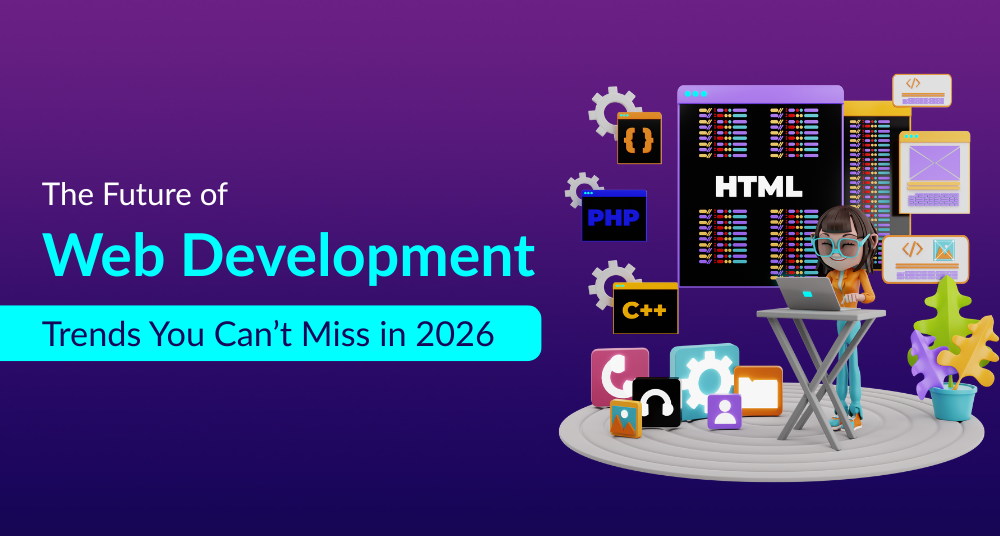The world of digital innovation is evolving faster than ever, and by 2026, the web as we know it will shift into an era defined by artificial intelligence, immersive user experiences, unparalleled speed, and security-first architecture. Businesses and developers alike need a clear roadmap to navigate the next wave of transformation.
This guide explores the biggest Web Development Trends shaping 2026 and what they mean for your digital strategy, whether you’re building a simple website, a full-scale enterprise platform, or a cutting-edge product experience that stands out in a competitive market.
Why Staying Updated with Web Development Trends Matters
The digital space is no longer a static environment. Websites must now behave like dynamic, intelligent platforms capable of adapting, personalizing, and performing at levels once thought impossible. Falling behind on Website Development Trends can result in:
- higher bounce rates
- security vulnerabilities
- loss of competitiveness
- reduced user trust
- outdated branding and user experience
On the other hand, staying ahead unlocks opportunities for innovation, efficiency, and revenue growth. By closely watching these trends, businesses can ensure their digital presence evolves with user expectations and technology advancements.
Top Web Development Trends to Watch in 2026
AI-Driven Development Becomes the New Normal
By 2026, AI is no longer just an add-on—it’s at the core of every development cycle. From intelligent code assistants to AI-powered debugging tools, automation will dramatically enhance developer productivity.
Key changes in 2026:
- AI-generated components and modules
- Automated code reviews and vulnerability scans
- Natural language coding interfaces
- AI-personalized content and layouts
Developers who embrace AI will build faster, smarter, and more scalable applications. Businesses must ensure their chosen Website Development Company is trained on and equipped with advanced AI development tools.
Hyper-Personalized User Experiences
2026 continues the trend toward personalization, but now with greater precision. Websites dynamically adjust content based on user behavior, browsing history, device type, preferences, and even predicted intent.
Examples include:
- personalized landing pages
- adaptive pricing or offers
- dynamic UI changes
- context-aware navigation
Personalization improves conversions and user satisfaction—making this one of the most critical Web Development Trends of the coming years.
WebAssembly (WASM) Goes Mainstream
WebAssembly is reshaping how high-performance applications run on the web. In 2026, WASM is essential for apps that demand speed and efficiency, such as:
- video editing tools
- AI inference engines
- 3D modeling and simulations
- gaming applications
WASM allows developers to use languages like Rust, C++, and Python for advanced web tasks, creating experiences previously impossible in JavaScript alone.
The Rise of Universal Apps
Universal applications—apps that work seamlessly across the web, mobile, desktop, and even embedded devices—are one of the most important Website Development Trends in 2026.
Key drivers:
- shared codebases using frameworks like Flutter, Next.js, and React Native
- powerful backend integrations
- unified user experiences across platforms
These apps save development time and ensure brand consistency while enabling app-level performance in web environments.
Voice-Enabled and Gesture-Based Interfaces
As more users rely on voice assistants and gesture-controlled devices, web platforms must adapt.
Voice search optimization has expanded into:
- voice navigation within sites
- voice-controlled web apps
- conversational interfaces powered by LLMs
Gesture interfaces are emerging in AR/VR settings, bringing new interaction models to e-commerce, education, and entertainment.
Zero-Trust Security Architecture for Web Platforms
Cybersecurity is at the forefront of all development decisions, and 2026 marks the widespread adoption of Zero-Trust architecture across the web.
Zero-Trust principles include:
- verify every request
- continuous authentication
- user segmentation
- identity-based access
Web developers must integrate advanced security layers—AI threat monitoring, biometric authentication, and encrypted sessions—into every project.
Ultra-Fast Web Performance with Edge Computing
Edge computing reduces latency and improves availability by processing data closer to the user.
Benefits in 2026:
- instant page loads
- real-time data synchronization
- faster API responses
- improved scalability
This trend will define how global brands deliver digital experiences, especially those with large user bases across different regions.
The Maturation of No-Code and Low-Code Development
No-code and low-code platforms continue to empower non-developers while also helping development teams prototype and deploy faster.
2026 enhancements:
- AI-generated workflows
- enterprise-grade app integrations
- customizable components
- improved scalability
While these tools won’t replace developers, they will shift their roles toward architectural oversight and integration management.
Sustainability-Focused Web Development
Eco-friendly web development is evolving into a major priority. Companies now measure carbon footprints of websites and digital operations.
Sustainable practices include:
- energy-efficient hosting
- lightweight code
- optimized media delivery
- reduced data transfer requirements
This trend aligns with global commitments to reduce digital carbon emissions and encourages brands to adopt greener strategies.
3D, AR, and VR Experiences Become Standard
Immersive technologies are becoming mainstream across shopping, education, entertainment, and real estate.
Examples in 2026:
- 3D product previews
- VR showrooms
- AR-based user manuals
- immersive onboarding experiences
Advances in browser technology and powerful GPUs make these interactive experiences widely accessible.
What These Trends Mean for Businesses
The Web Development Trends of 2026 push organizations to rethink how they build and evolve their digital presence.
Key benefits for businesses:
- higher engagement
- better customer retention
- improved security
- competitive advantage
- scalable digital ecosystems
Companies that adapt early will enjoy increased brand loyalty, operational efficiency, and faster go-to-market processes.
How Developers Should Prepare for 2026 and Beyond?
To thrive in the evolving landscape, developers should focus on:
1. Learning AI-integrated tooling
Mastering AI-coding assistants, automation workflows, and ML model integrations will be essential.
2. Building cross-platform applications
Universal apps will become a standard expectation.
3. Enhancing security knowledge
Understanding authentication, encryption, and Zero-Trust frameworks is foundational.
4. Exploring WASM and high-performance development
These skills will be essential for next-gen applications.
5. Embracing immersive and multidimensional design
3D and AR/VR implementation skills will be in high demand.
6. Prioritizing clean, sustainable coding practices
Energy-efficient development will be a required skill, not a bonus.
Choosing the Right Website Development Company in 2026
Selecting a Website Development Company in 2026 requires more than just browsing portfolios. Businesses should evaluate companies based on:
- AI capabilities (automation, personalization, predictive UX)
- security-first approach (Zero-Trust, biometric authentication, compliance frameworks)
- cross-platform expertise (web, mobile, desktop, IoT)
- WASM and high-performance programming experience
- ability to deliver immersive experiences (3D, VR, AR)
- sustainability and performance optimization practices
- transparent development cycles and agile methodologies
Partnering with the right experts ensures your digital ecosystem is future-proof, scalable, and able to adapt to the next wave of innovations.
Final Thoughts
The Website Development Trends shaping 2026 reflect a new era of intelligent, secure, fast, and immersive digital experiences. The combination of AI, WebAssembly, universal applications, gesture and voice interfaces, edge computing, and sustainable practices is redefining what modern websites and platforms can achieve.
Businesses and developers who embrace these innovations will be positioned at the forefront of digital excellence. Whether you’re upgrading your current platform or building a new solution from the ground up, understanding these Web Development Trends will prepare you for the future—and help you stay competitive in an increasingly digital world.
FAQs
What are the most important Web Development Trends to watch in 2026?
The most influential Web Development Trends in 2026 include AI-driven development, WebAssembly adoption, hyper-personalized user experiences, voice and gesture-based interfaces, Zero-Trust security architecture, and the rise of universal applications. These trends shape how businesses build faster, smarter, and more secure digital experiences.
How will AI impact website development in 2026?
AI will automate repetitive coding tasks, generate UI components, power personalization engines, and assist in debugging. Developers will rely on AI-powered tools for productivity, and businesses will lean on AI to deliver dynamic, responsive, and highly personalized websites.
Why is WebAssembly (WASM) so important for future web apps?
WebAssembly allows developers to run high-performance code in the browser, making complex applications—like video editors, simulations, AI models, and 3D tools—run at near-native speed. It is a major reason why many modern Website Development Trends focus on performance and advanced functionality.
How do I choose the best Website Development Company in 2026?
In 2026, the best Website Development Company will have strong expertise in AI-powered development, security-first architecture, cross-platform universal app creation, performance optimization, and immersive tech like AR/VR. Businesses should also look for transparent workflows, a strong portfolio, and sustainable development practices.
Are immersive experiences like AR and VR necessary for all websites?
Not all websites require AR or VR, but industries like real estate, e-commerce, healthcare, gaming, tourism, and education benefit immensely from immersive experiences. As hardware and browsers evolve, more businesses will integrate 3D, AR, or VR elements to improve engagement and conversions.
What should developers focus on to stay competitive in 2026?
To stay competitive, developers should invest in learning AI-integrated tools, WebAssembly, cybersecurity best practices, cross-platform frameworks, and immersive technology development. Understanding sustainability-focused Website Development Trends will also help developers align with global digital efficiency standards.
Related Blog: Top Website Development Companies in India






What do you think?
It is nice to know your opinion. Leave a comment.